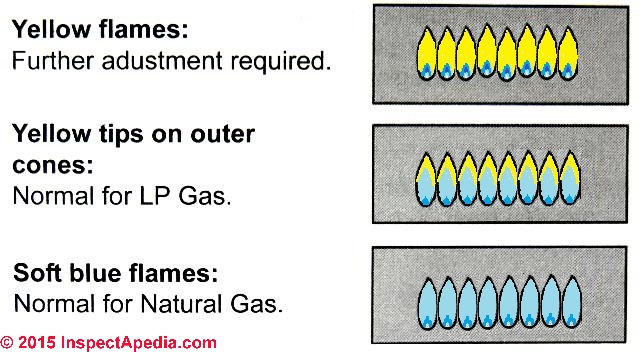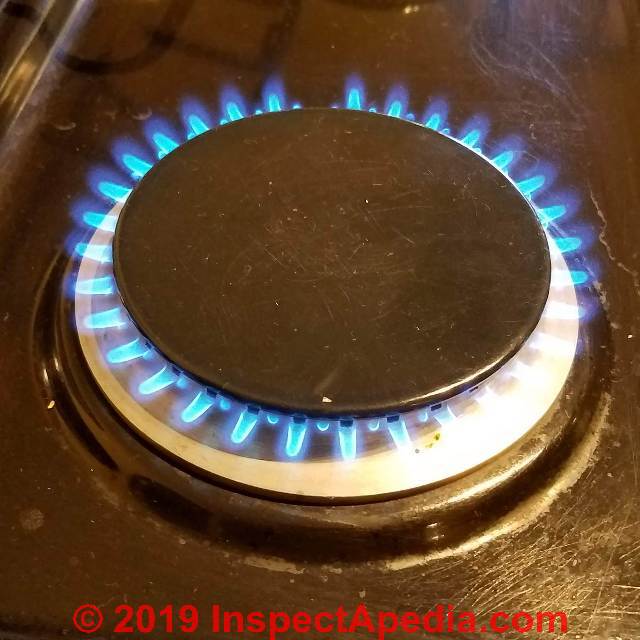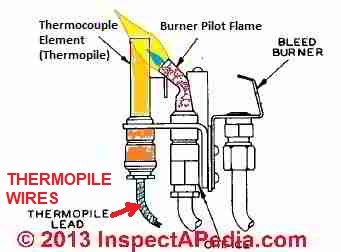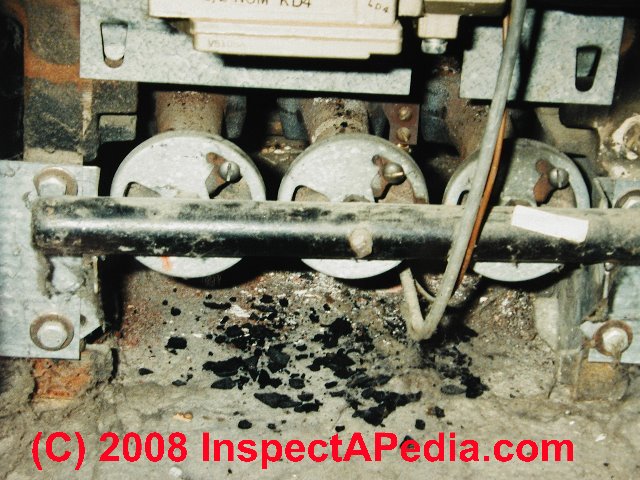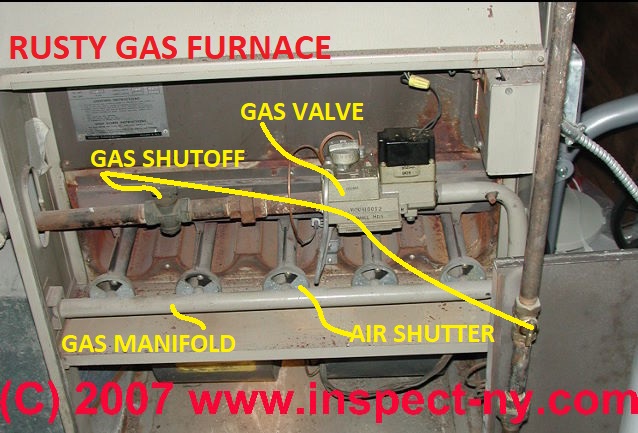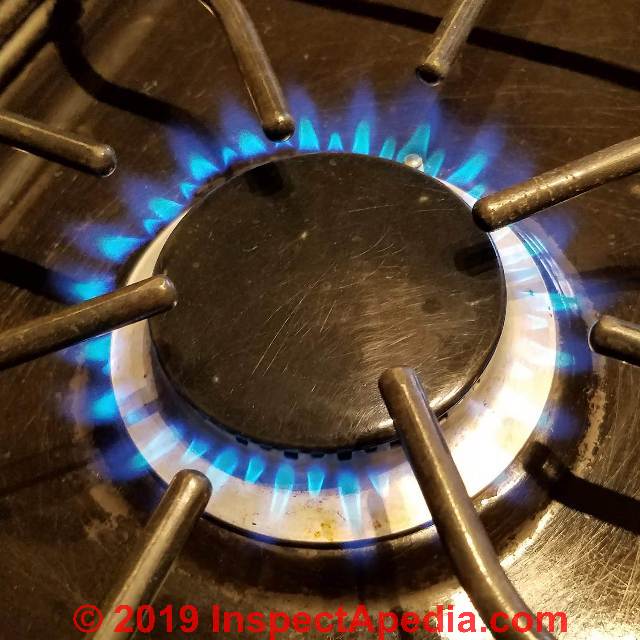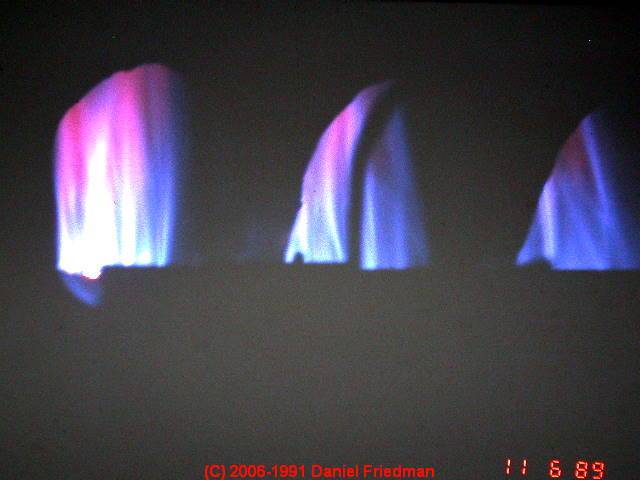 Gas Appliance & Gas Heater Flame & Noise Defects
Gas Appliance & Gas Heater Flame & Noise Defects
- POST a QUESTION or COMMENT about gas burner operating problems: flame defects, noises, safety hazards
Gas burner operating defects & noises:
Our gas flame colour illustration at page top illustrates a questionable irregular gas flame at the burner of a gas-fired heating furnace.
Looking into three burner ports of this heater we see three very different burner flames, suggesting perhaps a debris-blocked burner tube or improperly-adjusted air shutters, or (less likely) a partly-blocked gas metering orifice.
These articles provide descriptions and photographs of unsafe or improperly operating gas appliances, gas heaters, furnaces, boilers of all types.
We include example home inspection or gas appliance inspection report language for reporting defects in gas piping & burner operation at heaters, ranges, ovens, water heaters or similar LP, propane, or natural-gas fired appliances.
InspectAPedia tolerates no conflicts of interest. We have no relationship with advertisers, products, or services discussed at this website.
- Daniel Friedman, Publisher/Editor/Author - See WHO ARE WE?
Gas Flame & Noise Defects
 Identify & Report Safety & Operating Defects in LP or Natural Gas Appliances by Examining the Gas Burner Flame or Burner Noises
Identify & Report Safety & Operating Defects in LP or Natural Gas Appliances by Examining the Gas Burner Flame or Burner Noises
Photo above: this old water heater's gas burner has rusted partly away, the flame is irregular, yet the heater seems to be working just fine. Details about this burner color and safety are just below.
Article Contents
- GAS BOILER or FURNACE FLAME APPEARANCE
- GAS PILOT LIGHT FLAME APPEARANCE
- RUST AT THE GAS BURNER - MEANING
- SOOT AT THE GAS BURNER: WARNING
- GAS BURNER INSPECTION POINTS & REPORTING
- GAS BURNER POPPING NOISES - separate article
[Click to enlarge any image]
Gas Burner & Flame Color Interpretation
Above we see the gas flame in a Cal-o-Rex Dur-A-Glas LP gas fired water heater installed in Bozos, Guanajuato. This water heater (geyser) was made in 1999 so we're looking at a water heater gas burner after sixteen years of use.
The photo offers a view of a damaged gas burner flame dispersing cone and also of the passage of gas combustion products up through the center flue of this calorifier. The flame colours are normal, mostly blue with yellow tips.
Our gas flame colour illustration shown above, adapted from Bosch (2014), shows how you might distinguish among the properties of the following:
- Unhealthy, mostly-yellow gas burner flames
(top illustration above, check the gas regulator and air mix) that can occur on either LP (or propane) or natural gas burners.
Also see GAS REGULATOR NOISES as problems with gas-air mixture can cause noise at the appliance regulator as well as defective gas flame or too-low gas flame.
- Healthy yellow tips on outer cones of otherwise blue flames
(center of illustration above) characteristic of LP or propane gas burner flames such as is illustrated in the photograph shown above - Healthy soft blue flames of a natural gas burner
(bottom of illustration above on this page) and in photo below (the small gap in flame tips at the 12-o-clock position in the photo marks the location of the igniter - and is not a defect.
Above we see a normal LP gas flame at the burner of a gas stove installed in Poughkeepsie, NY.
Also see GAS FLAME COLOR CHECK for more examples of gas flame color checks and the relationship between air mix and gas flame.
What the Bosch drawing and our photos above do not show are other gas burner flame defects such as noises, flame lifting off of the burner, flame jumping excessively, flame uneven, or blocked at some orifices by debris or spills or lastly and particularly dangerous, the presence of soot - an indication of a serious even fatal carbon monoxide hazard.
...
What should a Gas Furnace or Boiler gas Burner Flame Look Like?
When properly adjusted the gas burner for a 100,000 BTU gas furnace or gas boiler, will have a flame about 1" or so high. The top of the gas flame will roll slightly 90 deg across and be blue in color.
If the gas pressure is too high you will notice the tips of the flame much higher, pointed and orange in color. The orange gas flame color usually means there is too much gas for the air mix input. [Dust, debris, or other problems in the gas/air mix ratio, such as a mis-adjusted or blocked air intake at a gas
More about gas flame color and diagnostic suggestions is
at BLUE vs YELLOW COMBUSTION FLAMES and
More about the relationship between flame colour when burning oil or gas fuel is
...
What should the Gas Pilot Flame Look Like at a Gas Fired Boiler, Furnace, or Water Heater
For gas fueled heating equipment that uses a standing pilot, the pilot flame appearance is diagnostic.
Proper gas flame at a gas appliance pilot light
As we illustrate below, at the pilot light for a gas appliance, if your gas equipment is working properly, the gas flame will be blue and will extend beyond the thermocouple.
The pilot light gas flame will surround the thermocouple just below the tip. A slight yellow flame may occur where the pilot flame and main burner flame meet.
See details
...
What is the Meaning of Soot Found at the Gas Appliance or Heater Burner?
Watch out: General safety warning: improper installation and even improper inspection and testing methods involving natural or "LP" gas can involve dangerous conditions and risk fire or explosion.
If you smell gas you should leave the building immediately and should do so without doing anything that could create a spark such as operating a light switch or telephone. From a safe location, call your gas company's emergency line and/or your fire department.
Watch out: soot observed on or around an LP or or natural gas burner can be a sign of extreme danger. Normally gas fired appliances run rather clean and with no soot deposition.
But if there is a combustion air problem a system can soot up and even completely clog a flue with soot very quickly - in minutes or hours. The risk is potentially fatal carbon monoxide poisoning of building occupants.
See details
...
What Does Rust or Debris Mean when Found on a Gas Burner?
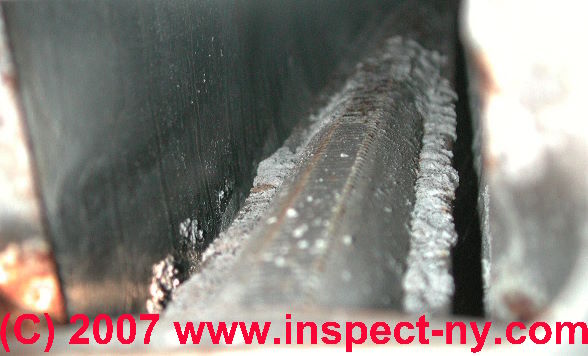
Excessive rusting every year usually accompanies these problems of improper gas pressure, inadequate combustion air, or wet conditions.
If you vacuum a lot of rust one year and it is back the next, then there is a problem that needs to be diagnosed and corrected.
Watch out: Rust can damage a heat exchanger, cause a hole, and make the heater unsafe.
Rust can also indicate general moisture conditions that could be causing other damage to or safety problems with the heater, including flue or chimney safety hazards.
Looking for rust on a gas heater's burner is a simple, quick visual check anyone can do to see if there is cause for alarm.
If rust is recurrent as we describe, further inspection is needed, and the gas pressure regulator should be checked as well.
Some of the residential gas furnaces or gas fired boilers show the correct flame patterns in their Installation and Operation Manuals.
Thanks to Charles or Mike Trumbature for suggesting this comment:
I see mostly Rheem furnaces in homes 20 - 30 years old. Rheem(TM) must have cornered the market at that time here in the Houston Texas area.
I've seen several homes in various areas with the same identical furnaces. I replaced a thermocouple on a relatively new unit once and noticed the "tame" flame pattern compared to my raging bonfire in my own furnace which was an older unit.
On my older gas furnace I was constantly cleaning out rust every year. That's when I checked the gas pressure at the gas regulator/valve and found it too high. My friend's heat exchanger still looked new, mine was a bucket of rust.
Readers should also
...
Example Gas Burner Inspection Points & Reporting Language
Here are some examples of gas appliance or gas heater inspection points, defects, and reporting language.
*** Safety Recommendation: gas grill we suggest keeping the gas turned off at the rubber hose connection below the rear deck as leaks could be very dangerous.
The use of rubber tubing rather than iron piping is unsafe and may not be permitted for this installation, and we suggest you review this question with your local fire inspector. Usually this is not a significant expense if correction is needed. This item should be addressed promptly.
Gas Appliance Flame Observations:
Caution: examining the burner when this appliance was operating we noted that the flame was floating above the burner ports.
You should check with your utility company or heating appliance service person. Possible causes include high gas pressure, clogged flue, inadequate air supply, excessive or very cold drafts.
Gas Appliance Flame Observations & Reporting checklist:
[Example heating system inspection report text is below]
Caution
At the ___ appliance, the gas burner flame was [example gas flame defects]
___ burning at the gas metering orifice
___ lifting off of the flame from the burner, possibly gas pressure too high - photo above - often accompanied by a rushing or roaring noise.
___ popping noise when turned off and on -
see GAS BURNER POPPING NOISES
___ gas burner roaring noise and unstable flame, flame too big, unusually high, noisy flame, possibly burner cap askew or gas pressure too high or both.
___ gas flame spilling out of the burner area
___ gas burner flame yellow and lazy [inadequate gas pressure or inadequate combustion air],
indicating a possible malfunction of this equipment.
Watch out: Any of these LP gas , propane, or natural gas burner conditions is potentially very dangerous and needs prompt attention. You should have your utility company or service person check the appliance immediately.
Immediate LP or natural gas safety hazards: if there is evidence of an LP or natural gas leak at a building, gas odors, for example, you should:
- Do not do anything that is likely to cause a gas explosion, such as lighting a match, operating an electrical switch, or even using a telephone in the building
- Leave the building immediately
- Notify other building occupants of the safety concern
- Contact the local gas company and/or fire department
The text provided here is a working draft and may be incomplete or inaccurate.
Contact us to suggest text changes and additions and, if you wish, to receive online listing and credit for that contribution.
NOTICE: while example report language is provided here, reproduction of this or any of our web pages or their contents at other websites or in printed documents for sale is prohibited.
...
Cause & Cure for Popping Noises at Gas Burners
This discussion has moved to
Watch out: these LP gas , propane, or natural gas burner conditions are potentially very dangerous and needs prompt attention. You should turn off the fuel supply to any gas appliance expected of leaking - to reduce the risk of a catastrophic gas explosion.
Gas Burner High Altitude Burner & Equipment Instructions + Manuals & Gas Flame Defects
This topic has moved to GAS APPLIANCE OPERATION at HIGH ALTITUDE
...
Reader Comments, Questions & Answers About The Article Above
Below you will find questions and answers previously posted on this page at its page bottom reader comment box.
Reader Q&A - also see RECOMMENDED ARTICLES & FAQs
On 2020-12-31 by Lawrs
Floating flame on center element of dyna glo. The other two elements are okay , no flame above element.
The center element is the main element. It is on all the time the heater is on.
On 2020-12-31 by (mod) - Floating flame on center element of Dyna glo
If no one has changed the flame or air shutter adjustment then I would be looking for a partial blockage or debris on the burner or at the gas orifice.
On 2020-12-26 by Carol A Tallman
I have a Mr. heater 30,000 BTU propane wall heater that started to flare up when it tries to light it also has started to give an unpleasant odor
It seems to happen when I have it turned up on a higher setting
I've cleaned it I've checked everything it's only seven months old and only used probably four of those months
On 2020-12-26 - by (mod) -
Carol
With the apology that we can diagnose your heater from just the information in your message, I agree that it sounds dangerous. There may be at least two hazards involved, a gas leak and an overheating problem.I think the system needs to be professionally inspected and adjusted and of course tested for leaks. If it were mine I would leave it off until I could have that done.
On 2020-10-01 by Gary Is the blue flame traveling backwards from the burner safe?
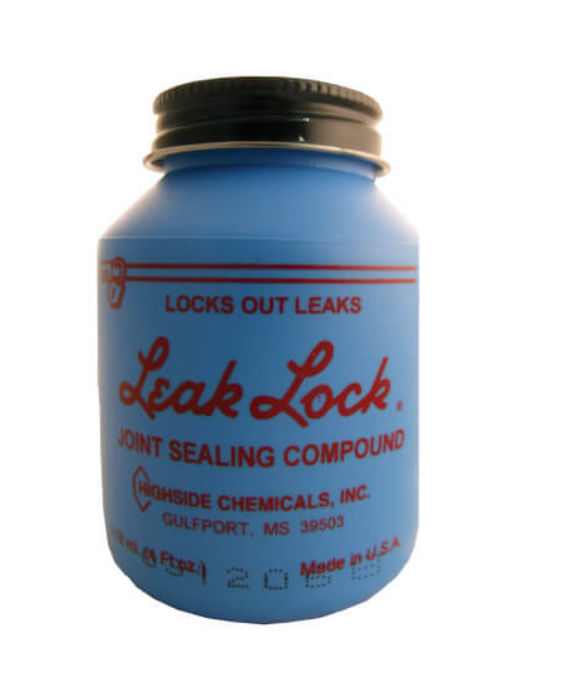 I have a home brew system that uses 3 "Chinese Wok" 10 jet burners connected to a natural gas source.
I have a home brew system that uses 3 "Chinese Wok" 10 jet burners connected to a natural gas source.
The jet tips are screwed into a cast iron "ring" that connects to a gas line. I noticed that sometimes the blue flame at the tip of the brass jet travels back to the base of the jet where the air holes for mixture are.
Is this a potential explosion hazard?
I have never noticed this before and have been using this system for years. Thank you.
Reply by (mod) -
Gary
I'd be nervous about that gas leak too as we can't be sure that at some later time you won't ignite a bolus of leaked gas, causing an explosion.
I would check and re-make each of the gas fitting connections with great care not to make matters worse by stripping the threads of brass or other fittings.
Use a thread sealant such as the Blue Leak Lock from Supco that I show below
- rated for use on gas fittings.
On 2020-08-20 by Jem - Gas jets on a 1968 Ci Motorhome Flavel Hob/Grill
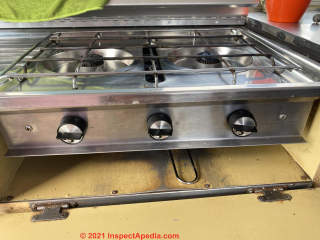 I have a 1978 Ci Motorhome with a Flavel hob/grill built in.
I have a 1978 Ci Motorhome with a Flavel hob/grill built in.
The grill works fine. The hob rings either side (as far as gas delivery rail is concerned) are very low and sometimes gurgle. The flames are totally blue however.
The jets dispense the gas into an open ‘funnel’ type opening that then goes along and up through the ring that is bolted in place so no loose caps etc.
Any help much appreciated as I cannot replace the unit as it is part of a sink/hob/drainer arrangement.
On 2020-08-22 - by (mod) -
If this has not always been a problem I'd look for low fuel or a blockage that can be cleaned.
On 2020-07-09 by Johan
I have a small cylinder gas heater with a screw on top, when I open the gas and ignite it, it makes big flames,what can be the problem?
On 2020-07-10 - by (mod) -
Wrong jet or gas metering orifice, wrong gas pressure or fuel type,
On 2020-02-11 by Bert krause
why is my new American Standard nat. Gas furnace burner very noisy and disruptive.
On 2020-02-11 - by (mod) - American Standard nat. Gas furnace burner very noisy
Bert
Without knowing anything about your system or where the noise appears to originate, I can't give a useful answer about why your new heating system is noisy.Watch out, however, If it appears to you that the noise is actually at the burner or burner Flame. The condition could be dangerous. If that's the case, I would turn the system off and call the installer for an immediate. Service and repair
On 2019-12-24 by Leo - Loud rushing sound when my LP stove burner ignites
I have never seen this before. One in maybe 40 startups of a LP gas heating stove (looks like an old fashioned wood burner) results in a loud rushing gas sound. The flame appears normal, only the sound is different. If the stove flame is extinguished and restarted via the thermostat then the roaring sound is gone.
The thermocouple voltage is on the low side, but it still keeps the pilot light lit. That's the only thing that appears even remotely less then how it should be.
Any ideas?
On 2019-12-25 - by (mod) -
Leo
Watch out: If the primary air supply into a gas burner is excessive that can cause a gas burner to ignite inconsistently, noisily or with a rushing noise.
Too much primary air can be caused by a problem with the LP or natural gas supply: gas pressure is too low.
That in turn can be caused by a sticking or defective gas pressure regulator or (rarely) by very cold weather and an LP gas tank that is nearly out of fuel.
Or, less common, there could be a defective gas valve itself.
Do you think perhaps the gas valve is improperly regulating and releasing gas into the burner? If so I'd consider that dangerous and I'd replace the valve.
On 2019-12-07 by Todd - Brick wall mounted propane heater whooshes if there's a breeze
I have a 3 brick wall mounted propane heater. When I turn it to 3 bricks the slightest breeze cause the heater to make a loud whoosh and then the bricks have a flame instead of the red glow.
Is there something that I can do to fix this?
On 2019-12-07 - by (mod) - whoosing at gas burner
Todd
See
GAS BURNER FLAME NOISES & DEFECTSOn 2019-12-08 by Todd
Thanks for the link but doesn't address my issue. I have a wall mounted vent free unit. It works fine until I turn to 3 brick and then any breeze causes issues.
It's almost as if air gets around the 3rd brick. Guess I'll take it somewhere to have looked at.
On 2019-12-08 - by (mod) -
Got it. Can you tell me
the heater brand and model
age
country and city of installation?
Perhaps post a photo using the "add image" button
so I can take a look at what the manufacturer says
Puffing Noise from Bosch cooktop burner
One of the gas burners on my (almost) new Bosch cooktop makes a "puffing" sound when it is turned on. There is a constant flame, but it puffs every couple of seconds. I thought might be air in the line, and I let it run for a minute, but the puffing noise continued. Now I'm afraid to use it. Any ideas? - On 2015-01-03 by
Reply by (mod) -
I've seen this puffing problem at gas log fireplaces too and on occasion traced it to a faulty regulator or dust. dirt, debris in a gas orifice. Try thorough cleaning of all of the parts
More information on puffing noises is
at HVAC NOISE-3 HISS HOWL HUFF HUM - hiss, howl, huff, hum, groan, woo wuu wuff
Constant humnming noise in my house - maybe from my gas heater?
I have a constant humming noise resonating through my house. It feels like a vibration.It is driving me crazy,and has been going on for years. It is not electric. I had the plumber out, he drained all the faucets,no luck.I have well and septic and an underground propane tank for heating and cooking. Please help. On 2014-06-06 by dee
Reply by (mod)
As you are posting on a gas burner flame defect page I'm guessing that you think the noise comes from your gas fired equipment.
So see the diagnostics
and for a more-complete humming noise source list see
HUMMING NOISES in BUILDINGS - home
Do gas fired heaters accept a muffler on the vent to reduce noise?
Is there a muffler or noise reduction part for the vent of a gas furnace - On 2014-05-26 by JohnReply by (mod) -
Not that I've come across, John.
I'd take a different approach. Find the actual cause for the noise that is bothersome. If that proves to be abnormal the there is a problem with the equipment to find and fix. The noise could indicate a coming equipment failure or even an unsafe condition.
Keep us posted.
Gas burner flames are bright orange and smell likd sulphur - is this dangerous?
My gas burner flames are burning bright orange , plus I've noticed a very strong sulphur smell coming from it every time i switch it on is this dangerous please ? On 2014-02-26 by Anonymous -
Reply by (mod) - quite possibly, yes
Anon,
With the caveat that no one can make a complete safe assessment of a building and its mechanical systems based on a simple text query such as that we have below. It is often the case that an expert will observe conditions that are not so apparent to normal building occupants.
Watch out: The article above cites and I re-mphasize that a change in gas flame color or odors as you describe are warning signs of improper combustion. The root problem could be trivial - dust on burners - or it could be very serious.
The danger is possibly fatal - death - in particular IF a gas fired appliance is producing carbon monoxide.
IF you have carbon monoxide detectors (CO detectors) properly installed, located, and working, and if those alarms have not sounded, then the risk assessment, while certainly not zero, is most likely less.
The safe course of action would be to turn off the equipment and call for help from your heating service company.
Our boiler intermittently shoots out flames upon ignition
Our boiler intermittently shoots out flames upon ignition of the natural gas.
We have had it inspected numerous times and the technician packs a cement into the area as a repair. It continues to do this though. We hear a loud boom at times when it is igniting. NOT a good sound. On 2012-12-18 by Rhonda Berger -
Reply by (mod)
I'd give your heating company service manager a call, politely and respectfully ask for an experienced gas boiler service technician to inspect and repair your boiler or to point out a chimney and venting defect if she or he finds that that's the problem.
Watch out: Note that you are raising a safety concern and that repeated service calles and adding cement somewhere on your boiler hasn't fixed the problem.
...
Continue reading at GAS BURNER POPPING NOISES or select a topic from the closely-related articles below, or see the complete ARTICLE INDEX.
Or see GAS BURNER FLAME NOISE & DEFECT FAQs - questions & answers posted originally at this article
Or see these
Recommended Articles
- BANGING HEATING SYSTEM NOISES
- GAS APPLIANCE CONVERT LP-to-NATURAL GAS
- GAS APPLIANCE OPERATION at HIGH ALTITUDE
- GAS BURNER FLAME & NOISE DEFECTS
- GAS BURNER PILOT LIGHT PROCEDURE
- GAS BURNER POPPING NOISES
- GAS BURNER RUMBLING CHUGGING NOISES
- GAS BURNER SOOT CAUSE & CURE
- GAS FIRED WATER HEATERS
- GAS REGULATORS & APPLIANCE / HEATER CONTROLS - also need adjustment for tall buildings or high altitude
- GAS LEAK DETECTION, LP / NG
- GAS PILOT WON'T STAY LIT
- GAS REGULATORS & APPLIANCE / HEATER CONTROLS
- GAS REGULATOR NOISES - buzzing, humming, and other noises at gas appliance regulators
- NOISE / SOUND DIAGNOSIS & CURE - home
- THERMOCOUPLE REPAIR / REPLACEMENT - pilot won't stay lit?
- WATER HEATER SCALE DE-LIMING PROCEDURE
Suggested citation for this web page
GAS BURNER FLAME & NOISE DEFECTS at InspectApedia.com - online encyclopedia of building & environmental inspection, testing, diagnosis, repair, & problem prevention advice.
Or see this
INDEX to RELATED ARTICLES: ARTICLE INDEX to GAS APPLIANCES, PIPING, CONTROLS
Or use the SEARCH BOX found below to Ask a Question or Search InspectApedia
Ask a Question or Search InspectApedia
Questions & answers or comments about gas burner operating problems: flame defects, noises, safety hazards.
Try the search box just below, or if you prefer, post a question or comment in the Comments box below and we will respond promptly.
Search the InspectApedia website
Note: appearance of your Comment below may be delayed: if your comment contains an image, photograph, web link, or text that looks to the software as if it might be a web link, your posting will appear after it has been approved by a moderator. Apologies for the delay.
Only one image can be added per comment but you can post as many comments, and therefore images, as you like.
You will not receive a notification when a response to your question has been posted.
Please bookmark this page to make it easy for you to check back for our response.
IF above you see "Comment Form is loading comments..." then COMMENT BOX - countable.ca / bawkbox.com IS NOT WORKING.
In any case you are welcome to send an email directly to us at InspectApedia.com at editor@inspectApedia.com
We'll reply to you directly. Please help us help you by noting, in your email, the URL of the InspectApedia page where you wanted to comment.
Citations & References
In addition to any citations in the article above, a full list is available on request.
- Bosch, "Gas Cooktops Installation Manual, NGM Gas Cooktops (NGM30, NGM50, NGM 56, NGM80, NGM86, NGMP65)", (2013), Bosch, 1901 Main St., Suite 600, Irvine CA 92614, Tel: 800-944-2904, Website: www.bosch-home.com
- Bosch, "LP Gas Conversion Kit Installation Manual , NGM Gas Cooktops (NGM30, NGM50, NGM 56, NGM80, NGM86, NGMP65)", (2014), Bosch, 1901 Main St., Suite 600, Irvine CA 92614, Tel: 800-944-2904, Website: www.bosch-home.com
- Bosch, "Gas Cooktops Use and Care Manual, NGM5055, NGM8055, NGM8065, NGMPO55, NGM5655, NGM8655, NGM8665, NGMP655", (11/13), Bosch, 1901 Main St., Suite 600, Irvine CA 92614, Tel: 800-944-2904, Website: www.bosch-home.com
- In addition to citations & references found in this article, see the research citations given at the end of the related articles found at our suggested
CONTINUE READING or RECOMMENDED ARTICLES.
- Carson, Dunlop & Associates Ltd., 120 Carlton Street Suite 407, Toronto ON M5A 4K2. Tel: (416) 964-9415 1-800-268-7070 Email: info@carsondunlop.com. Alan Carson is a past president of ASHI, the American Society of Home Inspectors.
Thanks to Alan Carson and Bob Dunlop, for permission for InspectAPedia to use text excerpts from The HOME REFERENCE BOOK - the Encyclopedia of Homes and to use illustrations from The ILLUSTRATED HOME .
Carson Dunlop Associates provides extensive home inspection education and report writing material. In gratitude we provide links to tsome Carson Dunlop Associates products and services.


